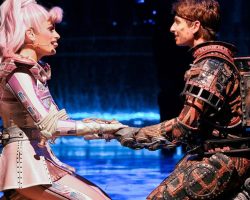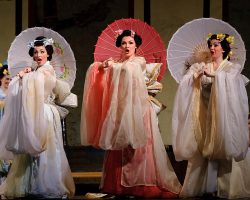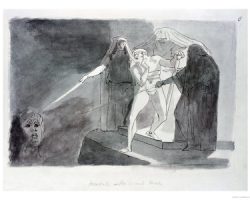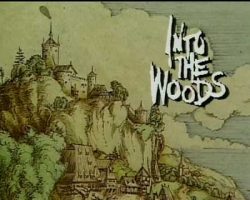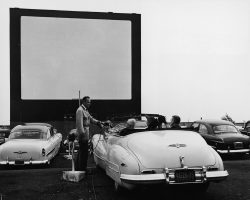Prisoner 24601, Trying to Outrun the Past
Jean Valjean, central character of Les Miserables, has been played by a host of great actors on stage and screen. Hugh Jackman is the Valjean of the new Les Mis movie musical. Jackman is a talented singer and stage performer who seems perfectly cast, but he follows in a line of great footsteps from previous Jean Valjean actors and singers. Meet here just some of the famous faces and voices who have starred as the former convict trying to be a good man in an unforgiving world.
Also discover the story of this man who raised himself up only to find others trying to drag him back down to the misery of life as a convict without hope.
Image credit: Portrait of Yvan Tourgueniev via Wikimedia Commons. Chosen for a resemblance to descriptions of Jean Valjean in his older years.
Who Was Jean Valjean?
Peasant, Convict, Mayor, Father
Jean Valjean Book Illustration (AllPosters.com)
Jean Valjean has many identities. The 3 volumes (or books) of the novel Les Misérables, written by Victor Hugo, follow his life from where he takes it up in middle age on being released as a convict up until his final days as an old man.
Valjean’s story is a sad one, but ultimately is a story of hope. He was born into poverty and describes himself in his early years as stupid and ignorant, though his later achievements show this to be a product of his background and not any lack of ability. Driven to theft by the hunger and suffering of his sister and her children, he was arrested and sent to the galleys as a convict. This was a brutal life, each day being a day of forced labor, chained to other convicts. His only thought was one of escape, and each time he attempted escape and was recaptured his sentence was extended.
So it was that Jean Valjean lost all of his youth and what could have been the most productive days of his life as a convict, engaged in mindless and back-breaking work. When he was finally released he was already a middle-aged man who bore the stigma of having been a ‘dangerous’ criminal for so many years. Only by running from the law and changing his identity could he have a chance to make his way in the world.
Religion is a strong theme in Hugo’s novel, and it was the mercy of a bishop that set Valjean on a new path of serving his God through good works and moral conduct.
Valjean worked hard, taking every opportunity to study and learn, and treated all he met with kindness and fairness. A natural businessman, he found great success which he used to make his town profitable, and reluctantly became Mayor. But Valjean’s success was short-lived, because on the tail of this reformed convict was a prison guard turned police inspector, who had resolved to capture the man who had evaded the law.
Jean Valjean, Illustration from Victor Hugo’s Les Misérables available from AllPosters.com.
Valjean, Javert, Fantine and Cosette
The Man Who Hunted Him Down, The Women He Wanted to Protect
The pursuit of Jean Valjean by Inspector Javert has captured the public’s imagination since Hugo first published his epic tale in 1862. The story creates a hero of a villain as Valjean overcomes his past and struggles to do what is morally right. And in Javert the man of law becomes an anti-hero, relentless in his determination to bring Valjean down.
Interwoven into their story is that of Fantine, a ‘fallen woman’, and her orphaned daughter Cosette. Via this tragic woman and the care of her neglected child, Valjean learns to love and even has a chance to take on the role of a father, making up for the family he never had.
However, Valjean finds that being a good man and taking care of the child he loves as his own means living a life on the run from the law.
Les Miserables on Stage and Screen
A Timeless Tale of Struggle and Redemption
Jordan Bennett as Valjean (Convict)
The story of Jean Valjean has been told many times in many ways. The first Les Misérables movie was made in 1909 and since then there have been many adaptations of the novel for theater and film.
It is the global success of the stage musical version of Les Misérables that has contributed most to the popularity of this story. Created by the now legendary French composer and lyricist duo, Schönberg and Boublil, ‘Les Miz’ made its debut in London in 1985 and has gone on to make musical theater history around the world. Jean Valjean is barely off the stage throughout the stage production, which is sung-through, meaning there is no pause in the singing for spoken lines. He therefore sings frequently in duets and counterpoint with other characters. His own famous song from the show is the emotional Bring Him Home. These challenges for both voice and acting make it one of modern-day musical theater’s greatest roles.
Les Misérables has not been neglected on the big screen either, and the coveted role of Valjean has been played by some of our most talented actors. For the first time in 2012/13 the movie and the musical meet as Hugh Jackman performs as Valjean in the first full movie version of Les Mis.
Image credit: Jordan Bennett as Jean Valjean. This image released into Public Domain by the actor via Wikimedia Commons.
Colm Wilkinson as Prisoner 24601
The Original Les Miserables Cast’s Jean Valjean
Colm Wilkinson on the cover of his album
Colm Wilkinson already had a singing career in his native Ireland before he created the stage musical role of Jean Valjean. In fact, some may remember him as Ireland’s entry to the 1978 Eurovision Song Contest. Colm earned his country a respectable 5th place in the contest, which is known for political voting. Fellow original Les Mis cast members Frances Ruffelle and Michael Ball have also separately performed at Eurovision, representing the UK.
Colm had already released his own album and assisted Andrew Lloyd Webber in the creation of the Phantom in the early stages of The Phantom of the Opera by the time he was cast as Valjean in the original London cast of Les Misérables. Wilkinson also opened Les Mis on Broadway after a casting struggle with Equity. He is held in high regard by many Les Mis fans as not only the first but the greatest Valjean. Colm turned 41 in the debut year of Les Misérables, making him a good fit for the middle-aged Valjean, and set the standard not only for the voice but also for the appearance of future Valjeans.
Colm Wilkinson followed his Les Mis role with the Phantom in the original Canadian cast of The Phantom Of The Opera, with Rebecca Caine (the original Cosette in Les Miserables) as Christine.
He resumed his role of Valjean in the legendary 10th Anniversary Dream Cast Concert of Les Miserables at London’s Royal Albert Hall and formed part of The Valjean Quartet of four of the greatest Jean Valjean performers singing Bring Him Home as part of the Les Miserables 25th Anniversary Concert celebration.
Colm Wilkinson has a cameo as the Bishop of Digne in the Les Misérables movie. He has a Christmas Concert tour in Canada at the end of 2012 and also can sometimes be seen on tour in his homeland of Ireland. His most recent screen appearance was as Lord Thomas Darcy in The Tudors.
Colm Returns to Les Miserables
Wilkinson as the Bishop of Digne in the Les Mis Movie
https://www.youtube.com/watch?v=yhpwV4cwB4o
Alfie Boe as Jean Valjean
The 25th Anniversary Concert Valjean
Alfie Boe on his album cover Love Was a Dream
British performer Alfie Boe brought a new interpretation of Jean Valjean to us when he starred in the Les Miserables 25th Anniversary Concert. It seems Boe can hardly be mentioned without referring to the fact that this talented singer was set for a career as a car mechanic. Fortunately for us, Boe auditioned for opera, going on to make a name for himself, and his versatile talent led to his selection as Valjean both in the 25th Anniversary O2 Concert in London and on the West End stage.
Alfie is one of the four Valjeans in The Valjean Quartet as they sing Bring Him Home. He has released a number of successful albums and in 2012/13 is touring the UK in concert.
Learn More About Alfie Boe
A Popular New Jean Valjean
Other Popular West End and Broadway Performers as Valjean
A Small Selection of Musical Theatre Talent
Everyone has a favorite Valjean and if you had a room full of Les Miz fans you would find that though some names would come up again and again, it would be impossible to agree on the ‘best’ Jean Valjean performer. I can’t begin to do justice to all the men who have played the central character of Les Miserables in London’s West End or on Broadway in New York, still less the international and touring productions. The below are just a few of the highly-rated Valjeans you may have heard of or been lucky enough to see in live performances.
John Owen-Jones has made one of the more recent appearances as Jean Valjean but the performer first appeared in the role when he was just 26. Owen-Jones took on the role for the Les Misérables 25th Anniversary Tour and appeared as Valjean both in London and on Broadway. He has also starred as the Phantom in The Phantom of the Opera and in 2012 is touring in this role. He was one of the four performers in The Valjean Quartet. Follow John Owen-Jones on Twitter.
Simon Bowman became part of musical theater history when he created the role of Chris (with Lea Salonga as Kim) in the original cast of Miss Saigon. His other West End roles have included Raoul in The Phantom of the Opera and he has been both Marius and Valjean in Les Mis in London. He joined Owen-Jones, Wilkinson and Boe in The Valjean Quartet.
Randal Keith impressed audiences with his Valjean when he toured in the role in the US, and performed on Broadway, plus in China and Korea. He was the final Valjean in the show’s Broadway run. Keith has also starred in The Phantom of the Opera in the States and has performed a number of other musical theater roles.
J. Mark McVey has been another popular Jean Valjean in the USA, winning a Helen Hayes award for his touring performance and playing the role on Broadway and in the Hollywood Bowl Les Miserables concert. Recently, fans have been again enjoying Mark’s performance in the US 25th Anniversary Les Misérables tour. Mark has released 2 CDs to date. Follow J. Mark McVey on Twitter
Back in London, Ramin Karimloo has been treating the West End to his Valjean before going on a tour of his own in 2012. Ramin, who is of Iranian descent, is one of the youngest Valjeans. He has also starred as the Phantom both in the original production and creating the role in Love Never Dies. He was Enjolras in the 25th Anniversary Les Miserables Concert and played the father of Christine Daaé in the 2004 movie version of The Phantom of the Opera. Ramin starred in The Phantom of the Opera at the Royal Albert Hall in 2011. Follow Ramin Karimloo on Twitter.
Jean-Paul Belmondo
A 1995 Variation on the Les Miserables Story
Jean Paul Belmondo (AllPosters.com)
Not an adaptation that stays true to the novel, but an interesting twist on the original tale. In this version from 1995, Jean-Paul Belmondo plays 3 men. One of these is Jean Valjean himself, one a father with a story that has tragic parallels with that of Valjean, and the third man is his son who aids Jewish refugees at the time of the persecution of the Jews during the Second World War.
Belmondo is a French screen legend, with the majority of his film work dating from the 1960s and 1970s. He is known both as a comedy actor and an action hero (famously doing all of his own stunts).
Liam Neeson
Les Misérables Movie 1998
Liam Neeson (AllPosters.com)
Liam Neeson headed a cast of stars in a film adaptation of the Les Misérables novel. Neeson’s Valjean was pursued by Geoffrey Rush as Javert, and he tended to Uma Thurman as the dying Fantine, later taking on care of her daughter Cosette played (as a teen) by Claire Danes.
Neeson stayed true to the novel with a morose and physically imposing Valjean who towered over Cosette and was more than a match for Javert (Neeson is 6′ 4″). However, he shared some tender moments with his Fantine that gave the impression that these two could under different circumstances been happy together.
Liam Neeson is of course a much-loved actor known for roles in popular movies such as Star Wars: Episode I – The Phantom Menace and The Dark Knight Rises as well as playing national figures such as Rob Roy and Michael Collins. He is also the voice of Aslan in The Chronicles of Narnia and one of his most acclaimed roles was as Oskar Schindler in Schindler’s List.
Trailer for 1998 Les Mis Movie
Neeson vs. Rush… It Doesn’t Get Much Better!
I admit, I can’t wait to see Jackman and Crowe, but Liam Neeson and Geoffrey Rush were also dream casting in this non-sung version of Les Miserables.
Gerard Depardieu
Les Misérables Mini-Series 2000
Gérard Depardieu (DVD Collection: Amazon.com)
Leading French actor Gérard Depardieu became Jean Valjean in a TV mini-series in the year 2000. He was joined by John Malkovich as Javert, with Charlotte Gainsbourg as Fantine.
Depardieu is well-known beyond France for his roles in Hollywood movies such as Green Card and The Man in the Iron Mask, and has a prolific career in French-language cinema ranging from Jean De Florette and Cyrano de Bergerac to Obélix in the various Asterix and Obelix movies.
Recent projects include Ang Lee’s Life of Pi.
Les Miserables Movie in 2000
Depardieu and Malkovich
This looks like a stunning adaptation of the novel. As a bonus for Eponine fans, her part hasn’t been cut from this particular version.
Hugh Jackman
Jackman Takes the Stage Valjean to the Big Screen
Hugh Jackman (AllPosters.com)
Hugh Jackman’s performance as Jean Valjean in the Les Misérables movie musical has been eagerly anticipated. Jackman is a popular actor both in Hollywood blockbusters such as the X-Men Trilogy and also in musical theater.
It’s hard to imagine better casting, as the star brings experience of both stage and screen to his Valjean. Jackman has already proven that he has the voice to perform nightly on Broadway in a one-man show, the charisma to host the Academy Awards, and the versatility as an actor to be a box-office favorite in a variety of movies. He also has the tall stature of Valjean and, for what it’s worth, is about the right age for Jean at the earlier stages of the movie.
Jackman can be seen starring as cowboy Curly in the musical revival of Rodgers and Hammerstein’s Oklahoma!, in which one of his co-stars was original Les Mis London cast member Peter Polycarpou. He is expected to follow Les Miserables with the role of the great entertainer P.T. Barnum in The Greatest Showman on Earth and will also making another appearance as Wolverine in The Wolverine.
Photo of Hugh Jackman available from AllPosters.com.
Hugh in Valjean Costume
Jackman’s video from the set of Les Mis
